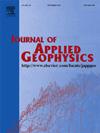Vehicle noise characteristics in magnetotelluric data and vehicle noise removal using waveform fitting
IF 2.2
3区 地球科学
Q2 GEOSCIENCES, MULTIDISCIPLINARY
引用次数: 0
Abstract
Magnetic field fluctuations due to vehicle noise were observed in magnetotelluric (MT) time-series data measured near roads. The observed vehicle noise had magnitudes ranging from tens to thousands of μA/m, whereas the observed weak natural MT signal magnitudes were approximately tens of μA/m. A small signal-to-noise ratio made it difficult to apply robust processing for removing vehicle noise. In addition, vehicle noise severely distorts the MT response in the MT deadband from 0.01 Hz to 0.3 Hz, where the MT signal is very weak, and methods to remove it are required for deep structure imaging. In this study, magnetic field fluctuations due to moving vehicles were simulated with a magnetic dipole and attempted to be removed using a waveform fitting method. A total of 378 vehicle noises were extracted from the near-road MT data and synthesized with the remote MT data without vehicle noises to investigate the effect of vehicle noise on the MT response. Removal of vehicle noise from synthesized remote MT data resulted in substantial restoration of the apparent resistivity and phase curves around the MT deadband and below 0.001 Hz. In the MT field data, the vehicle noise was simulated and removed with two moving dipoles; the magnitude of the remaining vehicle noise was reduced by approximately half compared to a single dipole, and very stable apparent resistivity and phase curves were obtained. Although electromagnetic noise distortion remains after vehicle noise removal, the waveform fitting method significantly improves the apparent resistivity and phase curve response in the 0.01–0.3 Hz frequency band.
磁无线电数据中的车辆噪声特征以及利用波形拟合去除车辆噪声
在道路附近测量的磁电潜能(MT)时间序列数据中观测到了由车辆噪声引起的磁场波动。观测到的车辆噪声幅度从几十到几千微安/米不等,而观测到的弱自然 MT 信号幅度约为几十微安/米。由于信噪比较小,因此很难采用稳健的处理方法去除车辆噪声。此外,在 MT 信号非常微弱的 0.01 Hz 至 0.3 Hz 死区,车辆噪声严重扭曲了 MT 响应,因此深部结构成像需要去除车辆噪声的方法。在这项研究中,利用磁偶极子模拟了移动车辆引起的磁场波动,并尝试使用波形拟合方法将其去除。从近路 MT 数据中总共提取了 378 个车辆噪声,并与不含车辆噪声的远程 MT 数据进行合成,以研究车辆噪声对 MT 响应的影响。从合成的远程 MT 数据中去除车辆噪声后,MT 死区附近和 0.001 Hz 以下的视电阻率和相位曲线得到了大幅恢复。在 MT 现场数据中,使用两个移动偶极子模拟并消除了车辆噪声;与单个偶极子相比,剩余车辆噪声的幅度减少了约一半,并获得了非常稳定的视电阻率和相位曲线。虽然去除车辆噪声后电磁噪声失真仍然存在,但波形拟合方法显著改善了 0.01-0.3 Hz 频段的视电阻率和相位曲线响应。
本文章由计算机程序翻译,如有差异,请以英文原文为准。
求助全文
约1分钟内获得全文
求助全文
来源期刊

Journal of Applied Geophysics
地学-地球科学综合
CiteScore
3.60
自引率
10.00%
发文量
274
审稿时长
4 months
期刊介绍:
The Journal of Applied Geophysics with its key objective of responding to pertinent and timely needs, places particular emphasis on methodological developments and innovative applications of geophysical techniques for addressing environmental, engineering, and hydrological problems. Related topical research in exploration geophysics and in soil and rock physics is also covered by the Journal of Applied Geophysics.
 求助内容:
求助内容: 应助结果提醒方式:
应助结果提醒方式:


